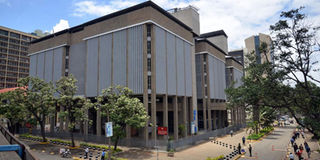Bank charges still full of grey areas

Central Bank of Kenya offices in Nairobi. FILE PHOTO | NMG
What you need to know:
- A study by the Financial Sector Deepening (FSD) Kenya found that banks are filing disclosures that fail to fully respect the tariff situation.
- While conducting the study, however, the report says it became clear that bank pricing data is difficult to obtain and that market information is still opaque.
- To collect data, researchers visited multiple bank branches posing as customers, as well as customer service call-lines and web searches to collate data.
Despite a push by the regulator to infuse transparency in the banking sector pricing, a new study by the Financial Sector Deepening (FSD) Kenya has raised a red flag over hidden costs charged to unsuspecting consumers.
The report finds that banks are filing disclosures that fail to fully respect the tariff situation.
“Although banks are required by the Central Bank of Kenya (CBK) to publish “tariff guides” with all their fees and charges, the FSD study found that many were either outdated, incomplete or lacking account specific information,” says FSD in the study whose findings are likely to put the regulator on the spot for failing to protect consumers.
“Despite visiting over 30 bank branches and consulting tariff guides, customer care representatives, bank websites, enquiring from colleagues and friends, over several weeks in 2015 and 2016, we still could not get consistent pricing information,” says FSD in the study.
The report outlines the findings from a two-year study by FSD Kenya, a UK-funded NGO, to understand the costs for banking services in Kenya.
It says two rounds of mystery shopping surveys were completed in October and November of 2015 and 2016 to build a database and measure the costs for basic bundles of transactions such as opening, running and closing bank accounts.
While conducting the study, however, the report says it became clear that bank pricing data is difficult to obtain and that market information is still opaque.
To collect data, researchers visited multiple bank branches posing as customers, as well as customer service call-lines and web searches to collate data.
The researchers said some data was difficult to obtain and validate, even from different branches of the same bank.
“While some charges are straightforward, such as ATM withdrawals costs, others are surprisingly difficult to obtain.”
In particular, it notes many branches displayed outdated tariff guides and complex pricing structures that even the frontline bank staff are not familiar with.
“The mystery shopper exercise mirrored a typical customer’s journey, with most customers obtaining information on banking from branches. The inability to obtain consistent information over several weeks of data collection reflects a transparency issue in the market.”




